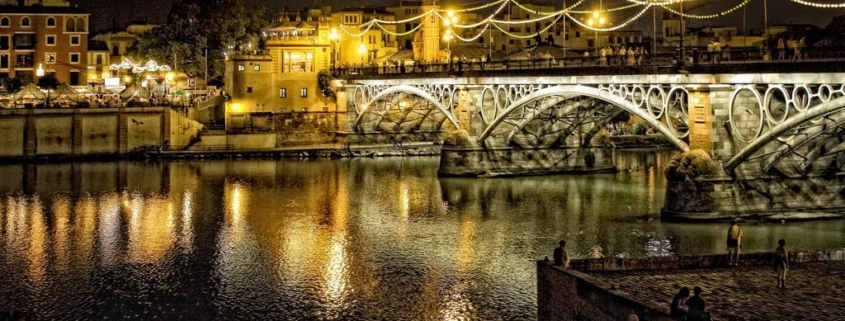Velá de Santiago y Santa Ana

Santa Ana, una gran fiesta a orillas del Guadalquivir.
Esta es la fiesta del barrio de Triana, una de las tradiciones que mejor le identifica. Desde el s. XVII se celebra esta fiesta en honor de la patrona de Triana. Es una fiesta que se vive sobre todo de noche. La Plaza del Altozano se convierte en un escenario donde se realizan cada noche El maravilloso barrio de Triana de Sevilla acoge durante esta semana la Velá de Santiago y actuaciones en directo de canción andaluza y flamenco. A los atractivos característicos de la Velá, como la Cucaña (un concurso donde los jóvenes compiten por llegar al pañuelo que se pone al final de la proa de un barco que previamente ha sido engrasada), o las típicas almendras verdes, se unen además los bares de las calles del barrio, como Pureza, Castilla, Betis o San Jacinto.
La noche del domingo nos trae otro de los momentos más bonitos con la iluminación del cielo mediante un castillo de fuegos artificiales que a las 12 de la noche celebran el día de Santa Ana y pondrán fin a las fiestas de la calle Betis y en el barrio de Triana.

Triana’s wonderful neighborhood of Seville receives during this week the Velá of Santiago and Holy Ana, a great holiday on the banks of the Guadalquivir.
This is the most famous festivity at the Triana district, situated at the other side of the historical section of the Guadalquivir River (Calle Betis). It has been held since the 17th century in honour to Santa Ana (Saint Anne), the patron saint of the area. You can enjoy this festivity especially in the evenings, from nightfall…Perhaps until dawn! Some special attractions are, for instance, “la Cucaña”, which is a competition in the river. All participants must walk along a boat’s bow covered with grease in order to catch the little flag placed at the very top of it; then you get the prize (usually a wonderful Iberian cured ham), or the stage at Plaza del Altozano where you can enjoy the purest flamenco shows every night. Furthermore, you can taste a number of different specialties of the popular Sevillian gastronomy at the bars and “casetas” placed around the premises, in the streets Pureza, Castilla, Betis, San Jacinto.

On Sunday night other of the nicest moments with the lighting of the sky by means of a castle of fireworks that at 12 p.m. they celebrate the day of Holy Ana and put the end to the velá de Santa Ana.
















